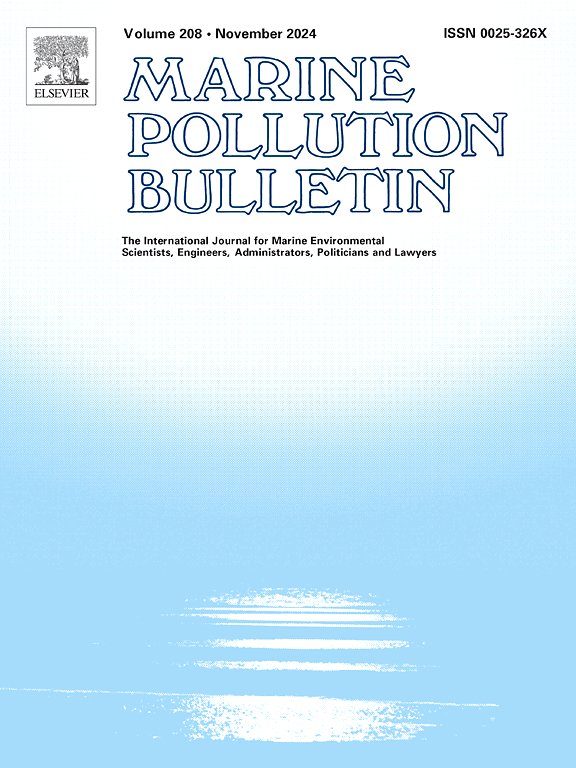氮输入通过微生物介导途径对温带盐沼土壤卤甲烷通量的影响
IF 5.3
3区 环境科学与生态学
Q1 ENVIRONMENTAL SCIENCES
引用次数: 0
摘要
卤甲烷(CH3Cl和CH3Br)是破坏臭氧层的重要大气微量温室气体。盐沼土壤是卤甲烷宝贵的天然来源和汇。氮输入对温室气体排放的影响是全球气候变化下温室气体收支的主要驱动力。然而,氮输入对盐沼土壤CH3Cl和CH3Br通量的影响尚不清楚。为此,研究了不同氮输入浓度下黄河三角洲盐沼土壤CH3Cl和CH3Br净排放的机制。结果表明,高浓度输入(18.0 g N·m−2·a−1)可使产气量增加7% (CH3Cl)和19% (CH3Br),而低浓度输入(9.0 g N·m−2·a−1)可使产气量增加24% (CH3Cl)和13% (CH3Br)。氮输入通过理化性质和微生物介导途径影响温带盐沼土壤卤甲烷净排放通量。土壤有机碳(SOC)和溶解有机质(DOM)是影响CH3Cl和CH3Br净排放的主要因子。高浓度的输入直接增加了有机碳和DOM的含量,刺激了卤甲烷的产生。其次,氮素输入后土壤养分的变化间接抑制了放线菌的丰度,抑制了卤甲烷的消耗。土壤中的非生物生产和生物降解过程共同决定了卤甲烷的净排放通量。在全球持续氮输入的背景下,高氮污染将进一步提高卤代甲烷的净排放通量。本文章由计算机程序翻译,如有差异,请以英文原文为准。
Effects of nitrogen input on halomethane fluxes via microorganism-mediated pathways in temperate salt marsh soil
Halomethanes (CH3Cl and CH3Br) are important atmospheric trace greenhouse gases that destroy the ozone layer. Salt marsh soils are valuable natural sources and sinks of halomethanes. The effects of nitrogen input on greenhouse gas emissions are the main driving force for greenhouse gas budgets under global climate change. However, the impacts of nitrogen input on CH3Cl and CH3Br fluxes in salt marsh soil remain unclear. Thus, we investigated the mechanisms of CH3Cl and CH3Br net emissions in Yellow River Delta salt marsh soil under different concentrations of nitrogen input. The results indicate that high concentration input (18.0 g N·m−2·a−1) increased gas production by 7 % (CH3Cl) and 19 % (CH3Br), whereas low concentration input (9.0 g N·m−2·a−1) increased gas consumption by 24 % (CH3Cl) and 13 % (CH3Br). Nitrogen input affected halomethanes net emission fluxes via physicochemical properties and microorganism-mediated pathways in temperate salt marsh soil. First, soil organic carbon (SOC) and dissolved organic matter (DOM) are the main factors that affected the net emissions of CH3Cl and CH3Br. High concentration input directly increases the contents of SOC and DOM, stimulating the production of halomethanes. Second, changes in soil nutrients after nitrogen input indirectly inhibited the abundance of Actinobacteria, inhibiting the consumption of halomethanes. The abiotic production and biodegradation processes in the soil jointly determined the net emission fluxes of halomethanes. High nitrogen pollution would further enhance the net emission fluxes of halomethanes under the context of continuous global nitrogen input.
求助全文
通过发布文献求助,成功后即可免费获取论文全文。
去求助
来源期刊

Marine pollution bulletin
环境科学-海洋与淡水生物学
CiteScore
10.20
自引率
15.50%
发文量
1077
审稿时长
68 days
期刊介绍:
Marine Pollution Bulletin is concerned with the rational use of maritime and marine resources in estuaries, the seas and oceans, as well as with documenting marine pollution and introducing new forms of measurement and analysis. A wide range of topics are discussed as news, comment, reviews and research reports, not only on effluent disposal and pollution control, but also on the management, economic aspects and protection of the marine environment in general.
 求助内容:
求助内容: 应助结果提醒方式:
应助结果提醒方式:


